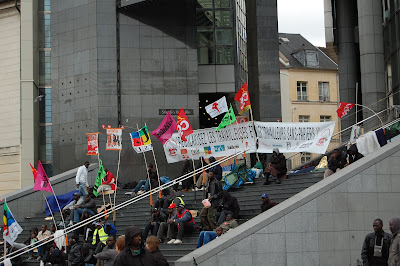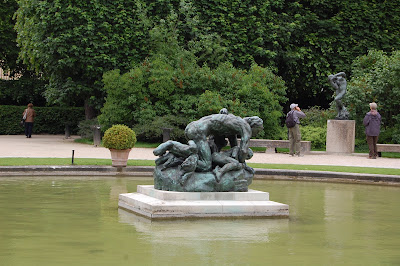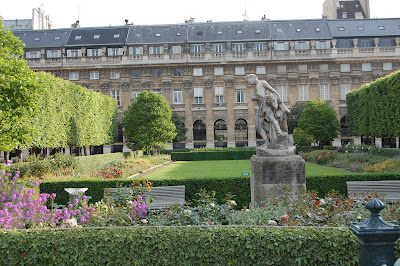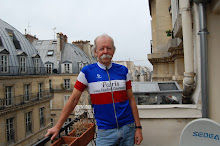So the free tennis player and myself got into the line for the Louvre in the guidebook preferred underground shopping mall a solid 15 minutes before opening and were only about 50 deep in the surge past security. I was allowed out of the queue at that point as I had no bag. The tennis player had to have his "purse" examined again. Ask him.
But we were in early and after some initial confusion arrived at "Winged Victory of Samothrace" well before the massive crowds that were there later in the morning.
 The free tennis player was castigated by the museum staff for stepping up onto what looked to him (and to me) to be part of the stairway for a photo op. Staff did not agree with our assessment but fortunately it was not an ejection offense.
The free tennis player was castigated by the museum staff for stepping up onto what looked to him (and to me) to be part of the stairway for a photo op. Staff did not agree with our assessment but fortunately it was not an ejection offense.There was only one person ahead of us when we arrived at "Aphrodite" more commonly known as "Venus de Milo".
 In a nearby room we came upon "Hercules and his son".
In a nearby room we came upon "Hercules and his son". Here at the far end of the room is some stuff that isn't even art, it is just part of the building. To be fair, there is a sign down there describing the building (this particular bit was done in 1570) and I suppose that is a concession that it is in fact art and the building sometimes IS art.
Here at the far end of the room is some stuff that isn't even art, it is just part of the building. To be fair, there is a sign down there describing the building (this particular bit was done in 1570) and I suppose that is a concession that it is in fact art and the building sometimes IS art. We wandered through the Etruscan antiquities section next on our way to Roman antiquities. It occurred to us later that we had casually walked past a few hundred of the most spectacular works of art to be found anywhere in the world without much more than a sideways glance.
We wandered through the Etruscan antiquities section next on our way to Roman antiquities. It occurred to us later that we had casually walked past a few hundred of the most spectacular works of art to be found anywhere in the world without much more than a sideways glance. Another example of not even art, just the building, this is the ceiling of one of the nine rooms which were the summer apartment of Anne of Austria when she was queen.
Another example of not even art, just the building, this is the ceiling of one of the nine rooms which were the summer apartment of Anne of Austria when she was queen. Here is a selection from the Roman antiquities section, the "Borghese Gladiator". I am pretty sure that any of these works can be googled if you desire more information. I will get around to it myself eventually but am not going to try to provide links today.
Here is a selection from the Roman antiquities section, the "Borghese Gladiator". I am pretty sure that any of these works can be googled if you desire more information. I will get around to it myself eventually but am not going to try to provide links today. This is in the area classified as Italian sculpture. This is "Hercules Fighting the Hydra". It is actually part of a fountain installed at the beginning of the 17th century in the gardens at Rueil, and in the 18th century in the park at Marly. It has been in the Louvre since 1872.
This is in the area classified as Italian sculpture. This is "Hercules Fighting the Hydra". It is actually part of a fountain installed at the beginning of the 17th century in the gardens at Rueil, and in the 18th century in the park at Marly. It has been in the Louvre since 1872. These two are by Michelangelo, the Dying Slave and the Rebellious Slave. The one in the middle is the free tennis player.
These two are by Michelangelo, the Dying Slave and the Rebellious Slave. The one in the middle is the free tennis player. This is the reception room of the apartment of Napoleon III.
This is the reception room of the apartment of Napoleon III. There is only so much art a person can absorb in one dose and our dose today was large indeed. Very shortly after opening the Louvre begins to lose its identity as a museum, quickly segueing into an exercise in crowd control. At one point three separate large groups of Japanese school girls were led into the rather smallish room where I was standing. The population of the room went from around 15 to around 90 in less time than it took to type this. One group after another had to be led up to the marble statue of a reclining hermorphadite to allow them to marvel at the feminine backside facing the room and the erect penis on the opposite side facing the window.
There is only so much art a person can absorb in one dose and our dose today was large indeed. Very shortly after opening the Louvre begins to lose its identity as a museum, quickly segueing into an exercise in crowd control. At one point three separate large groups of Japanese school girls were led into the rather smallish room where I was standing. The population of the room went from around 15 to around 90 in less time than it took to type this. One group after another had to be led up to the marble statue of a reclining hermorphadite to allow them to marvel at the feminine backside facing the room and the erect penis on the opposite side facing the window.You could almost actually feel the buses arriving. We looked out the window a time or two and marveled at the line which continued to grow in length even as the museum windows of commerce continued to admit new art lovers as fast as they could pay their €9.50.
We sought the "sortie" and headed back to our apartment. Along the way we got a photo from inside the pyramid entrance.
 And then we ran into this sassy French lady at a sidewalk cafe.
And then we ran into this sassy French lady at a sidewalk cafe. Our afternoon outing was to Montmarte. This landmark was right outside our Metro stop as we prepared to climb the big hill.
Our afternoon outing was to Montmarte. This landmark was right outside our Metro stop as we prepared to climb the big hill. We went into the Dali Museum where I got this photo of a giant "pust".
We went into the Dali Museum where I got this photo of a giant "pust". But after that my shutter refused to release, citing a need for recharging the battery. Life is not a photo opportunity but on the other hand the battery is at this moment in the charger. We have another day, I suspect there will be more photos. We are having a bunch of fun over here. I hope you all are too.
But after that my shutter refused to release, citing a need for recharging the battery. Life is not a photo opportunity but on the other hand the battery is at this moment in the charger. We have another day, I suspect there will be more photos. We are having a bunch of fun over here. I hope you all are too.





































